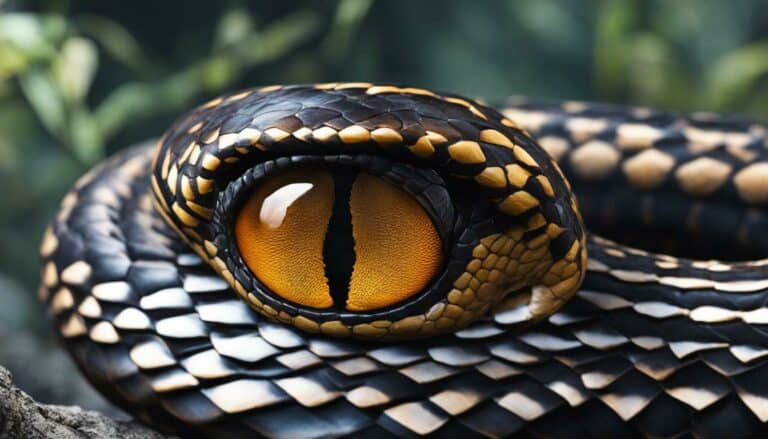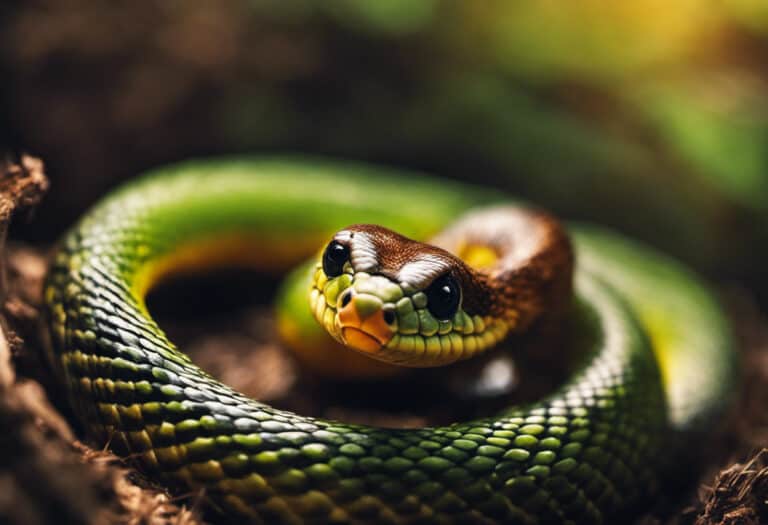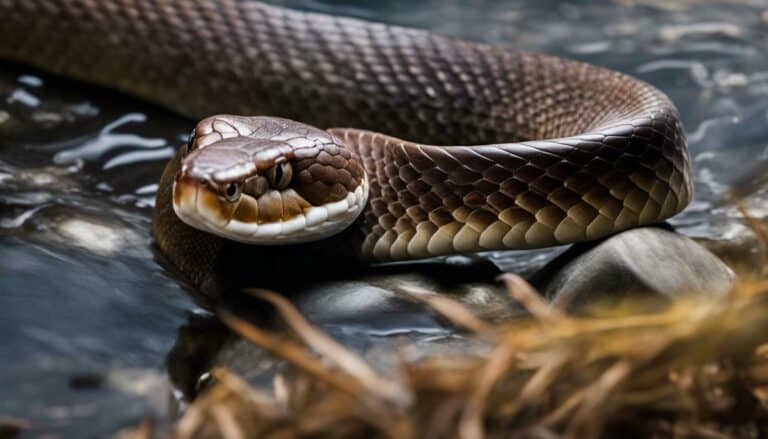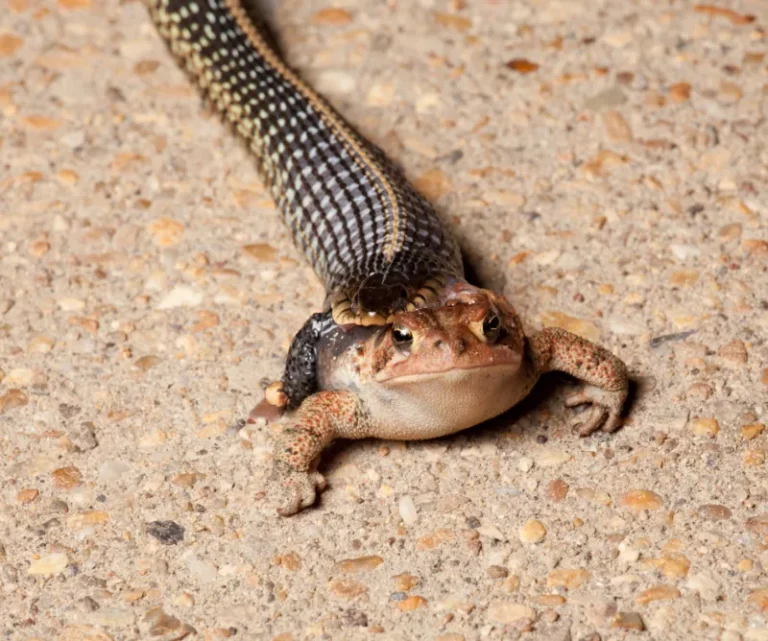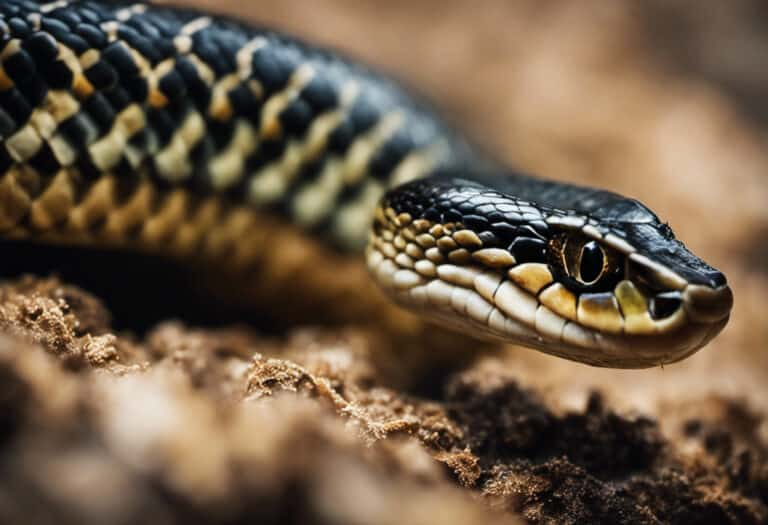How Long Can Snakes Go Without Water?
Do you ever wonder how long you could survive without water?
Snakes, fascinating creatures with incredible adaptations, face this challenge in their own unique way.
In this article, we will explore the water requirements of snakes, both in the wild and as pets.
Discover the signs of dehydration in these remarkable animals and the importance of providing them with a constant supply of fresh water.
So, get ready to dive into the world of snakes and uncover the significance of water in their survival.
Key Takeaways
- Snakes have evolved to need less water than most warm-blooded animals.
- Fresh water is still essential for the survival of snakes, both in the wild and as pets.
- Signs of dehydration in snakes include flaky shedding, dry skin, receding eyes, lethargy, constipation, and loss of appetite.
- While snakes can go weeks or months without drinking fresh water in the wild, it is important not to deprive pet snakes of water for more than a week to avoid health problems.
Water Requirements of Snakes
Fresh water is still essential for your pet snake’s survival, so make sure to set up their environment with a regularly cleaned water dish.
Snakes have unique hydration needs due to their ectothermic nature and slow digestive systems. While they’ve evolved to need less water than warm-blooded animals, fresh water is still vital for their overall health and well-being.
Snakes can obtain water from their food, which is typically composed of around 70% water, and through absorption through their skin. In the wild, snakes have strategies to collect and drink fresh water, such as collecting dew or rainwater on their backs.
However, as a pet owner, it’s your responsibility to provide a clean water source for your snake to ensure they stay hydrated.
Water Needs of Pet Snakes
Your pet snake, like its wild counterparts, still requires access to fresh water for its survival. Ensure that you set up its environment correctly by providing a regularly cleaned water dish, changing the water at least once a week, and washing the bowl with unscented, reptile-safe soap.
Depriving your pet snake of water for more than a week can lead to health problems, so it’s crucial to meet its water needs to keep it healthy and hydrated.
Hydration Methods for Snakes
Providing a clean water source that’s changed daily is essential for ensuring snakes stay hydrated and healthy in captivity. Snakes have specific requirements when it comes to water, and maintaining their hydration is crucial for their well-being. Here are three important factors to consider regarding hydration methods for snakes:
- Water temperature: Snakes prefer to drink water that’s at a temperature similar to their body heat. It’s recommended to provide water that’s slightly warmer than room temperature to encourage drinking.
- Water sources: Snakes should be provided with a shallow water dish that’s easily accessible. The dish should be cleaned regularly to prevent the growth of bacteria and to ensure the water remains fresh.
- Rehydration methods: If a snake shows signs of dehydration, such as sunken eyes or wrinkled skin, additional rehydration methods may be necessary. Soaking the snake in lukewarm water for 30 minutes can help replenish moisture. It’s important to offer fresh water for drinking after the soaking session.
Importance of Water Quality
Ensuring the water quality for your pet snake is essential for maintaining its health and well-being. Tap water may contain trace amounts of chlorine, which can irritate and inflame a snake’s skin, leading to respiratory problems and difficulty shedding. Monitoring the level of chlorine in tap water is vital for your snake’s health.
To remove chlorine from water, consider using water filtration systems or boiling the water. Providing your snake with access to chlorine-free water helps prevent irritation and promotes their overall well-being. Investing in a reliable water filtration system can significantly improve the water quality for your pet snake.
Signs of Dehydration in Snakes
To ensure the well-being of your pet snake, it’s crucial to be aware of the signs of dehydration. Watch for indications such as:
- Flaky shedding
- Dry skin
- Wrinkles
- Receding eyes
- Lethargy
- Constipation
- Loss of appetite
These symptoms may suggest that your snake is in need of hydration and prompt action should be taken to prevent further health issues.
Dehydration Prevention Methods
Make sure to regularly clean and change your pet snake’s water dish to prevent dehydration. Snakes have unique water consumption needs, and it’s crucial to provide them with a clean and fresh water source.
Here are three essential methods to prevent snake dehydration:
- Regular maintenance: Clean your snake’s water dish at least once a week to ensure it’s free from contaminants. Change the water regularly to keep it fresh and prevent the growth of harmful bacteria.
- Bathing routine: If your snake takes frequent baths, consider changing the water dish two to three times a week. This will help maintain the cleanliness of the water and prevent any potential health issues.
- Proper cleaning: Wash the soaking and drinking bowl with unscented, reptile-safe soap. Rinse it thoroughly to remove any residue that could be harmful to your snake. This will ensure that your pet has access to clean and safe drinking water at all times and help prevent dehydration.
Rehydration Techniques for Snakes
If you suspect dehydration in your pet snake, it is important to take immediate action and rehydrate them using methods such as soaking them in lukewarm water or offering fresh water directly.
Soaking techniques can be an effective way to replenish a snake’s hydration levels. You can place your snake in a shallow container filled with lukewarm water for about 30 minutes.
This allows the snake to absorb water through their skin. Another method is offering fresh water directly to the snake by using a dropper or syringe to place water in their mouth.
Additionally, ensuring that the water you provide is free from chlorine is crucial for the snake’s health.
Water filtration systems or boiling can help remove chlorine from tap water. By employing these rehydration techniques and maintaining proper water filtration, you can help keep your pet snake hydrated and healthy.
| Soaking Techniques | Water Filtration |
|---|---|
| Lukewarm water | Water filtration systems |
| Direct water intake | Boiling tap water |
| Hydration through skin absorption | Chlorine removal |
Importance of Water for Snake Survival
Snakes, including pet snakes, still need fresh water for their survival, even though they can go weeks or months without drinking in the wild. As masters of water conservation, snakes have adapted to thrive in arid environments. Here are three key points to consider:
- Water Adaptation: Snakes have evolved unique mechanisms to minimize water loss. They excrete solid waste, have slower digestion, and retain water through their scales. These adaptations allow them to survive for extended periods without drinking.
- Importance of Fresh Water: Despite their water-saving abilities, fresh water is still essential for snake survival. It’s crucial to provide pet snakes with a regularly cleaned water dish to ensure their hydration needs are met.
- Strategies in the Wild: Wild snakes have developed strategies to find and collect fresh water. Some species collect dew or rainwater on their backs, while others flatten their bodies to collect rainwater during rainfall. Sea snakes, living in saltwater, rely on rainwater found on beaches and shores.
Additional Information on Snakes and Water
While snakes have various strategies to collect and drink fresh water in the wild, it’s important for you to provide your pet snake with a clean water source in captivity.
Snakes in deserts, for example, collect dew or rainwater on their backs. Some snake species even flatten their bodies during rainfall to collect rainwater. However, sea snakes, despite living in saltwater, still need fresh water for their survival. They drink rainwater on beaches and shores. Sea snakes can go up to six or seven months without drinking fresh water.
Water is essential for all snakes’ survival, as it’s necessary for various bodily functions and overall well-being. So, make sure to provide your pet snake with a regularly cleaned water dish to keep them healthy and hydrated.
Water Needs and Survival of Snakes
To keep your pet snake healthy and hydrated, it’s important to provide them with a clean water source in their enclosure. Snakes have evolved to need less water than most warm-blooded animals. However, fresh water is still essential for their survival.
The effects of dehydration in snakes can lead to serious health issues, such as flaky shedding, dry skin, receding eyes, lethargy, constipation, and loss of appetite. The water intake in different snake species varies, but most snakes only need to consume water once or twice a week.
While snakes can go for long periods without water, it’s still necessary for their overall well-being. Therefore, it’s crucial to provide your pet snake with a regularly cleaned water dish and to monitor their water intake to prevent dehydration.
Dehydration in Snakes and Rehydration Methods
Now let’s delve into the important topic of dehydration in snakes and how to rehydrate them effectively. As a snake owner, it’s crucial to prevent dehydration in your pet to ensure their well-being.
Monitoring the water quality is an essential aspect of dehydration prevention. Tap water, although readily available, may contain trace amounts of chlorine that can irritate a snake’s skin and lead to respiratory problems. It’s vital to monitor the chlorine levels in tap water and take steps to remove it.
This can be achieved through the use of water filtration systems or boiling the water. By providing snakes with access to chlorine-free water, you can prevent irritation and promote their overall health.
Frequently Asked Questions
What Are Some Strategies That Wild Snakes Use to Find and Collect Fresh Water?
Wild snakes use various strategies to find and collect fresh water. They rely on environmental cues like rainfall, dew, and bodies of water. Some species flatten their bodies to collect rainwater, while others seek out natural water sources such as rivers, lakes, or puddles.
Can Snakes Absorb Water Through Their Skin in Arid Conditions?
Yes, snakes can absorb water through their skin in arid conditions, but it is not their primary source of hydration. Prolonged dehydration can lead to serious health consequences for snakes.
How Often Do Snakes Need to Consume Water?
Snakes’ water consumption frequency varies by species, but most only need to drink water once or twice a week. Providing a clean water source that is changed regularly is essential for captive snakes to stay hydrated.
Do Aquatic Snakes Drink Water Less Frequently Than Terrestrial Snakes?
Aquatic snakes, unlike terrestrial snakes, drink water less frequently due to their ability to absorb moisture through their skin while swimming. This adaptation allows them to survive in their watery habitats with less dependence on regular water intake.
Is Tap Water Safe for Snakes to Drink, or Does It Need to Be Treated to Remove Chlorine?
Tap water may contain chlorine, which can irritate snake skin and lead to respiratory problems. Removing chlorine through filtration or boiling is crucial. Distilled water is a safer option, as it lacks impurities and provides optimal hydration for snakes. Some snakes hibernate in water to conserve energy and regulate body temperature.
Conclusion
In conclusion, understanding the water needs of snakes is crucial for their survival and well-being.
While snakes have evolved to withstand periods without water, it’s essential to provide them with a constant supply of fresh water to prevent dehydration.
By recognizing the signs of dehydration and implementing rehydration methods when necessary, snake owners can ensure the health and longevity of their pets.
Remember, water isn’t just a luxury for snakes, but a fundamental requirement for their overall health and survival.
